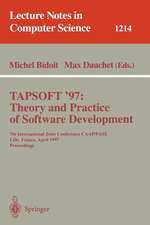Formal Methods in Systems Engineering
Editat de Peter Ryan, Chris Sennetten Limba Engleză Paperback – 16 iun 1993
Preț: 328.09 lei
Preț vechi: 410.12 lei
-20% Nou
Puncte Express: 492
Preț estimativ în valută:
62.79€ • 65.31$ • 51.84£
62.79€ • 65.31$ • 51.84£
Carte tipărită la comandă
Livrare economică 14-28 aprilie
Preluare comenzi: 021 569.72.76
Specificații
ISBN-13: 9783540197515
ISBN-10: 3540197516
Pagini: 208
Ilustrații: XI, 195 p.
Dimensiuni: 155 x 235 x 11 mm
Greutate: 0.3 kg
Ediția:1st Edition.
Editura: SPRINGER LONDON
Colecția Springer
Locul publicării:London, United Kingdom
ISBN-10: 3540197516
Pagini: 208
Ilustrații: XI, 195 p.
Dimensiuni: 155 x 235 x 11 mm
Greutate: 0.3 kg
Ediția:1st Edition.
Editura: SPRINGER LONDON
Colecția Springer
Locul publicării:London, United Kingdom
Public țintă
Professional/practitionerCuprins
1 Introduction.- 1.1 What Are Formal Methods?.- 1.2 Formal Methods and Mathematics.- 1.3 What Good Are Formal Methods?.- 1.4 The Myth of Control.- 1.5 Hyperprogramming.- 1.6 Recommendations.- 2 Formal Methods of Software Development: Painted into the Corner of High-Integrity Computing?.- 2.1 The Dominant Rationale for Formal Methods.- 2.2 Some Pragmatic Objections to Formal Methods.- 2.3 Dissolving Resistance to Formal Methods?.- 2.4 A Brief Sketch of Formal Methods in High-Integrity Computing.- 2.5 The Projects.- 2.6 The Formal Methods Community in High-Integrity Computing.- 2.7 The Information Networks.- 2.8 Does the Use of Formal Methods Within High-Integrity Computing Perpetuate its “Myths”?.- 3 The Social Negotiation of Proof: An Analysis and a Further Prediction.- 3.1 Background.- 3.2 VIPER.- 3.3 Disputing “Proof”.- 3.4 Formal Proof and Rigorous Argument.- 3.5 A Further Prediction.- 3.6 Conclusion.- 4 On Constructing Large Software Systems.- 4.1 Introduction.- 4.2 People.- 4.3 Frames.- 4.4 Sets.- 4.5 Programs.- 4.6 Proof.- 4.7 Tools.- 4.8 Conclusion.- 4.9 Acknowledgments.- 5 Composition of Descriptions: A Progress Report.- 5.1 Introduction.- 5.2 Why Compose Descriptions ?.- 5.3 What is Described?.- 5.4 What is a Description?.- 5.5 What is Composition?.- 5.6 Description Reuse.- 5.7 Conclusion.- 6 Integrating Methods in Practice.- 6.1 Introduction.- 6.2 Development and Development Methods.- 6.3 Aspects of Specification.- 6.4 Aspects of Design.- 6.5 Implications for Research and Development.- 7 Formal Methods and Product Documentation.- 7.1 Introduction.- 7.2 The Fully Formalised Software Product.- 7.3 The Elements of Product Documentation.- 7.4 Product Documentation and the Product Range.- 7.5 Product Documentation and Product Development.- 7.6 ProductDocumentation and Customers.- 7.7 Developing from a Fully Formalised Base.- 7.8 New Requirements.- 7.9 Errors Detected Before Release.- 7.10 Errors Detected After Release.- 7.11 How to Get There.- 7.12 Summary.- 7.13 Acknowledgments.- 8 Software Quality: A Modelling and Measurement View.- 8.1 Software Quality Needs.- 8.2 Modelling Software Experiences.- 8.3 Model Evolution.- 8.4 An Organization for Packaging Experience Models for Reuse.- 8.5 Conclusions.- 9 Modelling Working Group Summary.- 9.1 Description.- 9.2 Discussion Topics.- 9.3 Discussion.- 9.4 How Does Mathematical Modelling Help to Increase our Understanding of Digital Systems?.- 9.5 What is Required to Validate that a Mathematical Model Describes a Digital System Accurately?.- 9.6 Conclusions.- 10 Quality Assurance Working Group.- 10.1 Group Description.- 10.2 Quality Assurance vs. Quality Control.- 10.3 What Is a Formal Method?.- 10.4 Integration of Formal Methods and Quality Control.- 10.5 A Plan to Integrate Formal Methods into QC/QA.- 11 Design Methods Working Group.- 11.1 Description.- 11.2 The Context of Formal Methods.- 11.3 The Role of Proof in Assurance.- 11.4 Analytical Capabilities of Formal Methods.- 11.5 Foundational Capabilities of Formal Methods.- 11.6 The Role of Formal Methods with Respect to the Software Development Process.- 11.7 Formal Methods During Development and Implementation.- 11.8 Education.- 11.9 Tools.- 12 Conclusions.- A Survey of Formal Methods Tools.- B Survey of Formal Methods Applications.- C Acronyms and Trademarks.- List of Contributors.






















